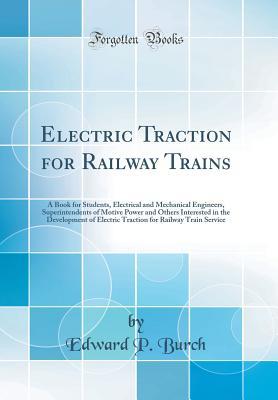Read Electric Traction for Railway Trains: A Book for Students, Electrical and Mechanical Engineers, Superintendents of Motive Power and Others Interested in the Development of Electric Traction for Railway Train Service (Classic Reprint) - Edward P Burch | PDF
Related searches:
Electric Traction for Railway Trains: A Book for - Amazon.com
Electric Traction for Railway Trains: A Book for Students, Electrical and Mechanical Engineers, Superintendents of Motive Power and Others Interested in the Development of Electric Traction for Railway Train Service (Classic Reprint)
Electric Traction for Railway Trains: A Book for - Google Books
Electric Traction for Railway Trains - Forgotten Books
Electric Traction Power The Railway Technical Website PRC Rail
NDLI: Electric traction for railway trains; a book for students
File:Electric traction for railway trains; a book for students, electrical
Electric Traction for Railway Trains; A Book for Students, Electrical
Electric Traction Control The Railway Technical Website
Buy Electric Traction for Railway Trains: A Book for - Amazon.in
Voith electric traction systems – Optimal traction for rail vehicles Voith
BASIC MODELING FOR ELECTRIC TRACTION SYSTEMS - DiVA
Train Movement and Energy Consumption Electrical Engineering
300+ TOP ELECTRIC TRACTION Objective Questions and Answers
Mathematical model of the train movement: regime of traction vehicle drives. Calculation of the electrical conditions in the contact line system:.
Electric traction for railway trains: a book for students, electrical and mechanical engineers, superintendents of motive power and others by edward parris burch, first published in 1911, is a rare.
General aspects of railway traction what really causes the train to accelerate or br ake are the adhesion forces that appear in the wheel-rail contact. For these adhesion forces to appear, tractive or braking effort needs to be applied to the wheels. This torque must be generated in a motor or braking system that.
Some electric traction systems provide regenerative braking that turns the train's kinetic energy back into electricity and returns it to the supply system to be used by other trains or the general utility grid. While diesel locomotives burn petroleum, electricity can be generated from diverse sources, including renewable energy.
In - buy electric traction for railway trains: a book for students, electrical and mechanical engineers, superintendents of motive power and others�.
An “electric locomotive” is a railway vehicle that can move along rails and push or pull a train attached to it using electric power drawn from an external source, usually from overhead cables or a third rail.
The track electrification refers to the type of source supply system that is used while powering the electric locomotive systems.
File:electric traction for railway trains; a book for students, electrical and mechanical engineers, superintendents of motive power and others (1911) ( 14778626643).
1 dec 2017 consumption rates for those train operators using regenerative braking. (b) a rules change process for amending these traction electricity.
Disadvantages of electric traction include: high capital costs that may be uneconomic on lightly trafficked routes, a relative lack of flexibility (since electric trains.
Electric traction for railway trains: a book for students, electrical and mechanical engineers, superintendents of motive power and others by edward parris.
Electric traction is widely used around the world, particularly for routes with dense traffic, like urban and suburban railways or long distance, high speed lines that need electric traction to obtain the speeds required for inter-city travel. There are a number of different systems of electric traction and these are described here.
Electric traction has a very important advantage over steam traction and that is on account of greater adhesive weight – in a motor coach 100 per cent of the weight is on the driving wheels, in an electric locomotive 70 per cent whereas in a steam locomotive less than 50 per cent.
Electric traction for railway trains; a book for students, electrical and mechanical engineers, superintendents of motive power and others (english, paperback,.
(redirected from list of current systems for electric rail traction) this is a list of the power supply systems that are, or have been, used for tramway and railway electrification systems� note that the voltages are nominal and vary depending on load and distance from the substation.
Electric traction for railway trains; a book for students, electrical and mechanical engineers, superintendents of motive power and others.
1 jun 2020 department of electronic, electrical and systems engineering, university of birmingham.
Electric traction for railway trains; a book for students, electrical and mechanical engineers, superintendents of motive power and others content source: internet.
You receive characteristic information about the driving dynamics and the traction system, as well as a recommendation for the optimally matching traction inverter.
In a railway system, a voltage drop causes the trains to run slower, while in the ordinary power system some consumers occasionally have to be disconnected.
Railway electric traction describes the various types of locomotive and multiple units that are used on electrification systems around the world.
The power circuit on the train is completed by connecting the return to brushes rubbing on the axle ends.
Electric traction for railway trains: a book for students, electrical and mechanical engineers, superintendents of motive power and others - primary source edition paperback – october 28, 2013 by edward parris burch (author) 4 ratings.
Direct current (dc) traction units use direct current drawn from a third rail, fourth rail, ground-level power supply or an overhead line.

Post Your Comments: